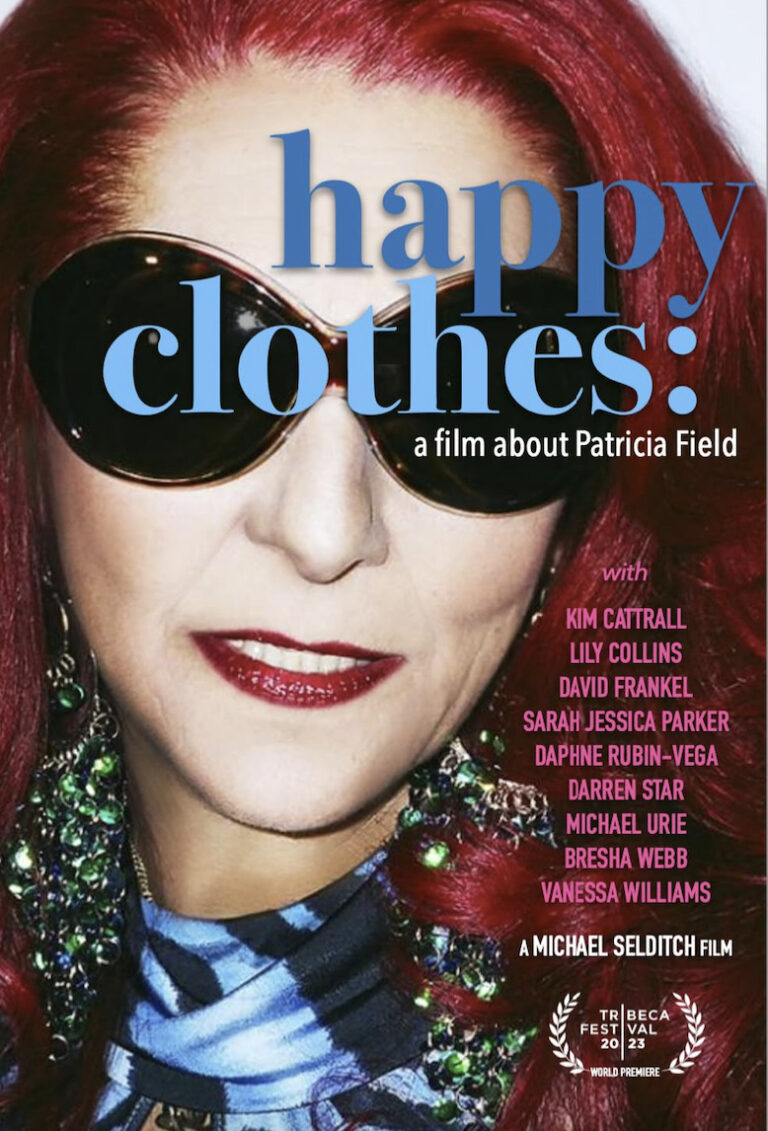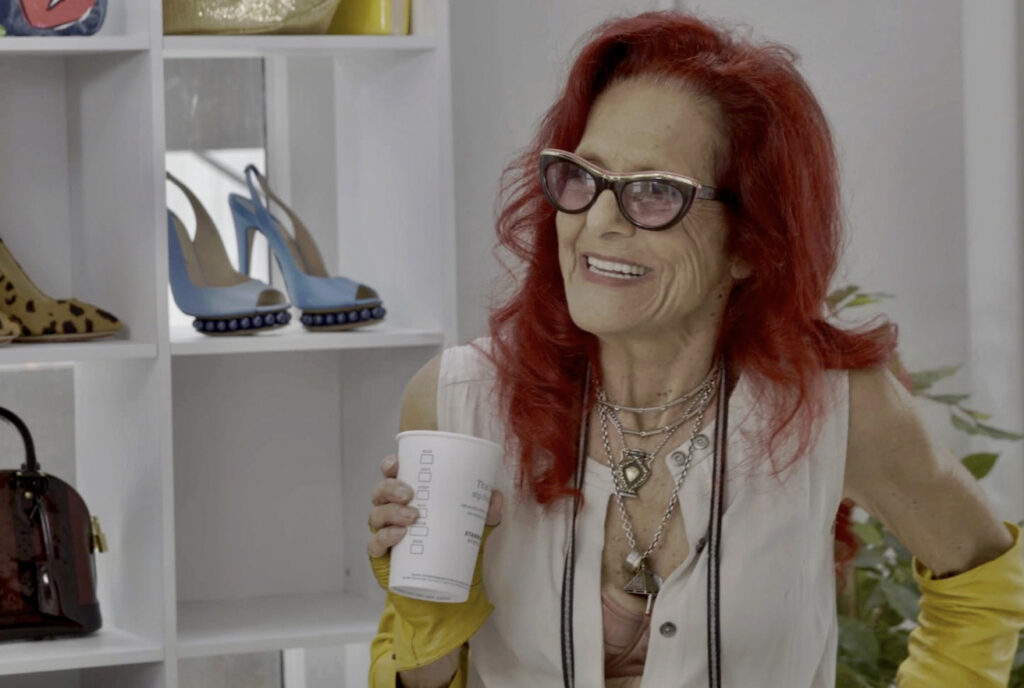
Synopsis : Carrie Bradshaw’s tutu. Miranda Priestly’s hair. Betty Suarez’s red-framed glasses. Even if you haven’t heard of Patricia Field, there is no doubt you’re deeply familiar with her legendary designs. “Happy Clothes: A Film About Patricia Field” takes a deep dive into the storied life of this iconic costume designer. Take a walk down memory lane with Field and her endless list of friends, team members, and collaborators to see how some of the most memorable film and television costumes came to life.
Field was the costume designer for the 1987 film “Lady Beware” and the TV series “Crime Story.” After she met Sarah Jessica Parker during the filming of 1995’s Miami Rhapsody,” they became friends and Field was engaged to design the costumes for the TV series “Sex and the City.” The show became well known for its fashions, particularly for their individuality and unexpectedness.Emmy Awards For her work on “Sex and the City,” Field was nominated for five Emmy Awards with one win, and nominated for six Costume Designers Guild awards, with four wins.
This film featured interviews with television fan favorites Kim Cattrall (“Sex and the City”), Lily Collins (“Emily in Paris”), Sarah Jessica Parker (“Sex and the City“), Darren Star (creator of “Sex and the City“ and “Emily in Paris“), Michael Urie (“Ugly Betty“), Vanessa Williams (“Ugly Betty“) and more, this film delves behind the scenes with Field and uncovers the thought process behind her designs.

Exclusive Interview with a Famed Fashion Designer Patricia Field and Director Michael Selditch
Q : Patricia, could you talk about your Patricia Field Art Gallery where we’re conducting this interview?
PF: I feel that the gallery was an idea that I had — an art-fashion gallery. As far as I know, it’s the only one of its kind. I’m happy that the business is surviving and being identified. It also helps other people to know about the gallery. I never really wanted to do an on-the-street situation. I wanted it to be more intimate, and when I found this place I was like, “Okay, this used to be dentists’ offices.” So we opened it all up.
Q: Michael, how did you approach Patricia to make this intimate and a wonderful body of her works through the film in the first place?
MS: I was working on a four-part documentary series for CNN called “American Style” [2019], and I interviewed a whole bunch of people for that. Pat was one of them, and her interview was awesome. After she left, I said to the crew, “Somebody needs to make a documentary on this woman.” And that’s how it started.
Q: Patricia, your mother was in the dry cleaning business and you used to help her work. How much of that experience contributed to you becoming the designer who you’re now?
PF: The experience of my youth with my mom definitely had a strong effect on me. From my mom I learned business. Her shop wasn’t far away from where we lived in Manhattan, and as I got a little bit older — she had maybe five, “drop stores” I call them — with no machinery or anything, people would come and leave their things. That was my environment, so I learned a lot about business from that environment.
For example, when my mom’s employees were gone for their vacation — I was like 13 or whatever — I would go in there and run the drop store, where then they would pick up the clothes. My mom had a factory and they would do all the clothes there. So it was just my normal way of life.
Q: You describe your store as a daytime club. How do you describe your creative relationship with the New York club scene? Your stores were popular with the transgender and underground communities, you became known for what you called “freaky fashion.”
PF: As far as describing my store as a daytime club, it just evolved that way, with people that I hired who impressed me with their fashion sense. I think that basically gave my shop a unique identity, let’s say. And believe me, I only know that because I heard it. I was in my shop working with the kids that I hired, doing my thing. I never really thought of it as anything particular. But sometimes when I read things about the shop, I’m like, “Oh, that’s good.” It was a certain environment. JoJo used to work in the shop, and Paul — they’re all people that I still have a relationship with through the years.
MS: You were also always attracted to the youth around you and were inspired by them.
PF: It’s true. I’m young at heart, so I relate to the youth. I have more in common with the youth.

Q: You also designed the outfits for Japanese singer, Namie Amuro’s music videos for her three songs —“ New Look,” “Rock Steady,” and “What A Feeling.” Talk about the collaboration with Amuro?
PF: Not just Amuro, I had a very large Japanese experience in my life, in my world and my business. I used to go shopping in Tokyo, and became very close friends with a Japanese gal named Masako Kato. Masako is gone now — unfortunately, she had cancer. But there’s a museum outside of Tokyo — some of my staff who are Japanese kids — were in his museum. Now they want me to come because they’re doing this exhibit of my art which the owner purchased — a lot of pieces — and he’s making a show with this art. It’s all good.
But I don’t know if I would enjoy Tokyo without Masako. We were very, very close. She had a shop in Harajuku where I was standing outside the shop looking in her window. She approached me and we started talking, and from there we just became really good friends. I’m still in touch with her family today, and her child who, at the time that she passed, was about two years old. Now she’s a teenager.
Q: In “Sex and the City,” the four women have strong individual characters. How did you collaborate with them and have that very distinctive design of the clothes for each character which became the signature for the show.
PF: Of course, there’s the script, and it describes the character. I worked with them on a very personal basis — who they are and what their style is. I don’t ever try to impose a style on an actor that they don’t feel comfortable in. After all, they’re in front of the camera, portraying the character, so that collaboration is very important.
Q: Michael, working with such an original designer, what element surprised you the most about her — how she approached the coworkers and how she talked with the actors?
MS: I honestly don’t know if anything surprised me about working with Pat. What you see is what you get with Pat, and all the things that made me want to make this documentary turned out to be true. Pat’s incredibly creative, funny and smart, and all of that was really validated as I worked on this project with her.
Q: Pat, talk about the film “The Devil Wears Prada.” Did Meryl Streep have an idea prior to working with you? How did you collaborate with her for the clothes and looks?
PF: I’m a huge fan of Meryl Streep because she’s one of the most professional actors that I’ve ever met. I was a huge fan of hers before. When David [Frankel], who was the creator and director, called me and told me about this project, and he said “Meryl Streep”, I said, “I’ll take it.” She’s very intelligent, I love working with her. She’s very inspiring, knows what she likes, is very expressive and communicative in the way she works. It was a total pleasure for me.

